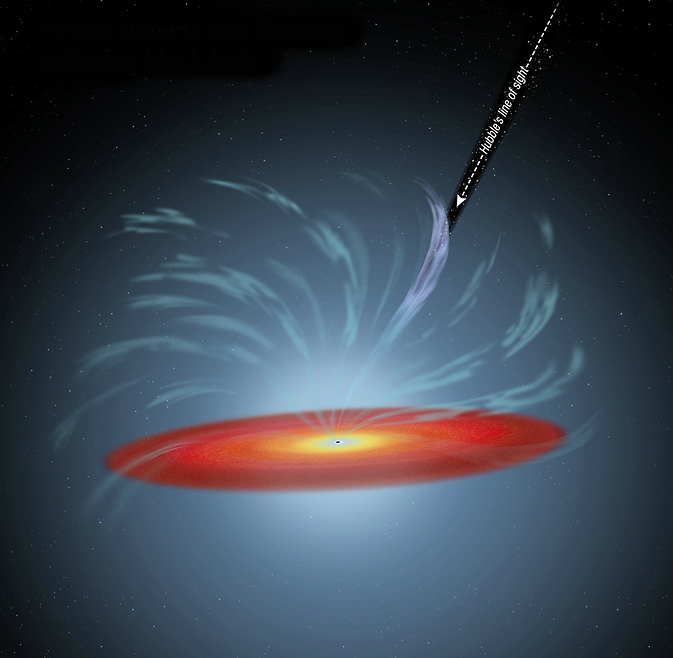Swiftly Moving Gas Streamer Eclipses Supermassive Black Hole

In this illustration, the position of a dark, absorbing cloud of material is located high above the supermassive black hole and accretion disk in the center of the active galaxy NGC 5548. Numerous other filaments twist around the black hole as they are swept away by a torrent of radiation "winds." Image Credit: NASA, ESA, and A. Feild (STScI)
Immediately after NASA's Hubble Space Telescope observed NGC 5548 in June 2013, this international research team discovered unexpected features in the data. They detected a stream of gas flowing rapidly outward from the galaxy's supermassive black hole, blocking 90 percent of its emitted X-rays.
“The data represented dramatic changes since the last observation with Hubble in 2011,” said Gerard Kriss of the Space Telescope Science Institute (STScI) in Baltimore, Maryland. “I saw signatures of much colder gas than was present before, indicating that the wind had cooled down due to a significant decrease in X-ray radiation from the galaxy's nucleus.”
The discovery was made during an intensive observing campaign that also included data from NASA's Swift spacecraft, Nuclear Spectroscopic Telescope Array (NuSTAR) and Chandra X-ray Observatory, as well as ESA's X-ray Multi-Mirror Mission (XMM-Newton) and Integral gamma-ray observatory (INTEGRAL).
After combining and analyzing data from all six sources, the team was able to put together the pieces of the puzzle. Supermassive black holes in the nuclei of active galaxies, such as NGC 5548, expel large amounts of matter through powerful winds of ionized gas. For instance, the persistent wind of NGC 5548 reaches velocities exceeding 621 miles (approximately 1,000 kilometers) a second. But now a new wind has arisen, much stronger and faster than the persistent wind.
“These new winds reach speeds of up to 3,107 miles (5,000 kilometers) per second, but is much closer to the nucleus than the persistent wind,” said lead scientist Jelle Kaastra of the SRON Netherlands Institute for Space Research. “The new gas outflow blocks 90 percent of the low-energy X-rays that come from very close to the black hole, and it obscures up to a third of the region that emits the ultraviolet radiation at a few light-days distance from the black hole.”
The newly discovered gas stream in NGC 5548 — one of the best-studied of the type of galaxy know as Type I Seyfert — provides the first direct evidence of a shielding process that accelerates the powerful gas streams, or winds, to high speeds. These winds only occur if their starting point is shielded from X-rays.
It appears the shielding in NGC 5548 has been going on for at least three years, but just recently began crossing their line of sight.
“There are other galaxies with similar streams of gas flowing outward from the direction of its central black hole, but we've never before found evidence that the stream of gas changed its position as dramatically as this one has,” said Kriss. “This is the first time we've seen a stream like this move into our line of sight. We got lucky.”
Researchers also deduced that in more luminous quasars, the winds may be strong enough to blow off gas that otherwise would have become “food” for the black hole, thereby regulating both the growth of the black hole and that of its host galaxy.
These results are being published online in the Thursday issue of Science Express.
The Hubble Space Telescope is a project of international cooperation between NASA and the European Space Agency. NASA's Goddard Space Flight Center in Greenbelt, Maryland, manages the telescope. STScI conducts Hubble science operations and is operated for NASA by the Association of Universities for Research in Astronomy, Inc., in Washington.
For images and more information about Hubble, visit:
J.D. Harrington
Headquarters, Washington
202-358-5241
j.d.harrington@nasa.gov
Ray Villard
Space Telescope Science Institute, Baltimore, Md.
410-338-4514
villard@stsci.edu
Media Contact
All latest news from the category: Physics and Astronomy
This area deals with the fundamental laws and building blocks of nature and how they interact, the properties and the behavior of matter, and research into space and time and their structures.
innovations-report provides in-depth reports and articles on subjects such as astrophysics, laser technologies, nuclear, quantum, particle and solid-state physics, nanotechnologies, planetary research and findings (Mars, Venus) and developments related to the Hubble Telescope.
Newest articles

Silicon Carbide Innovation Alliance to drive industrial-scale semiconductor work
Known for its ability to withstand extreme environments and high voltages, silicon carbide (SiC) is a semiconducting material made up of silicon and carbon atoms arranged into crystals that is…

New SPECT/CT technique shows impressive biomarker identification
…offers increased access for prostate cancer patients. A novel SPECT/CT acquisition method can accurately detect radiopharmaceutical biodistribution in a convenient manner for prostate cancer patients, opening the door for more…

How 3D printers can give robots a soft touch
Soft skin coverings and touch sensors have emerged as a promising feature for robots that are both safer and more intuitive for human interaction, but they are expensive and difficult…





















